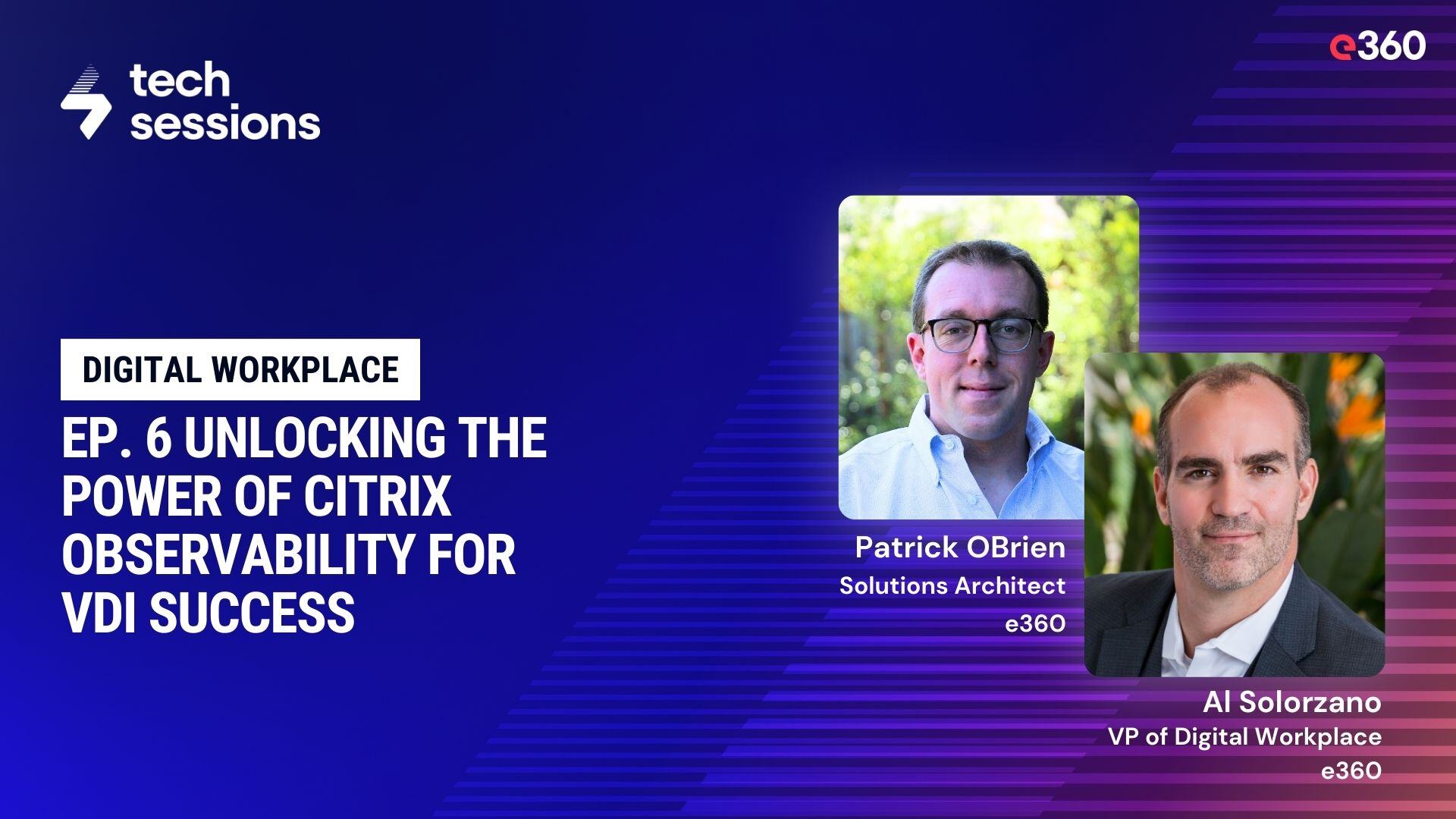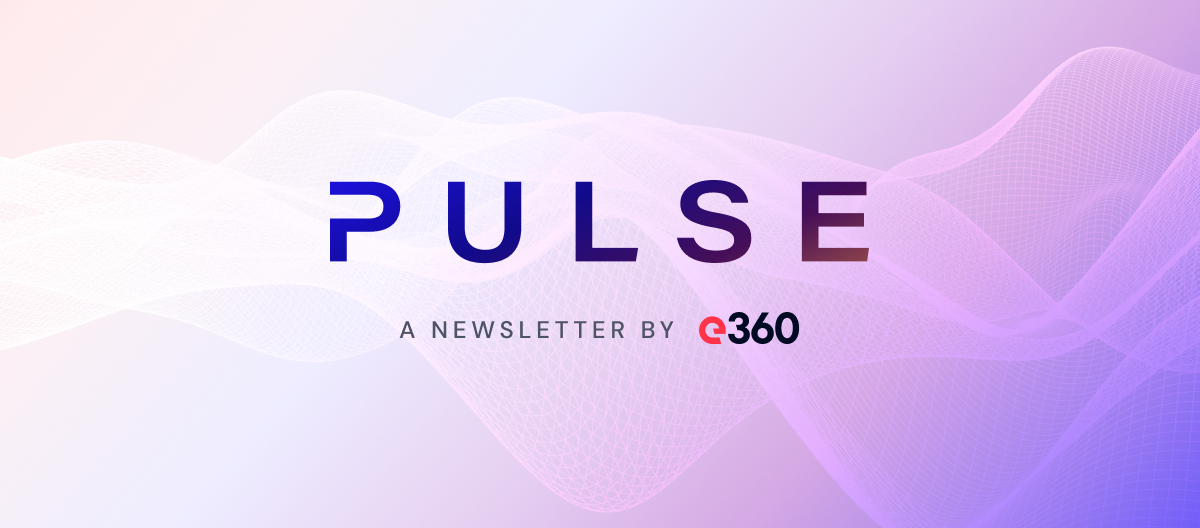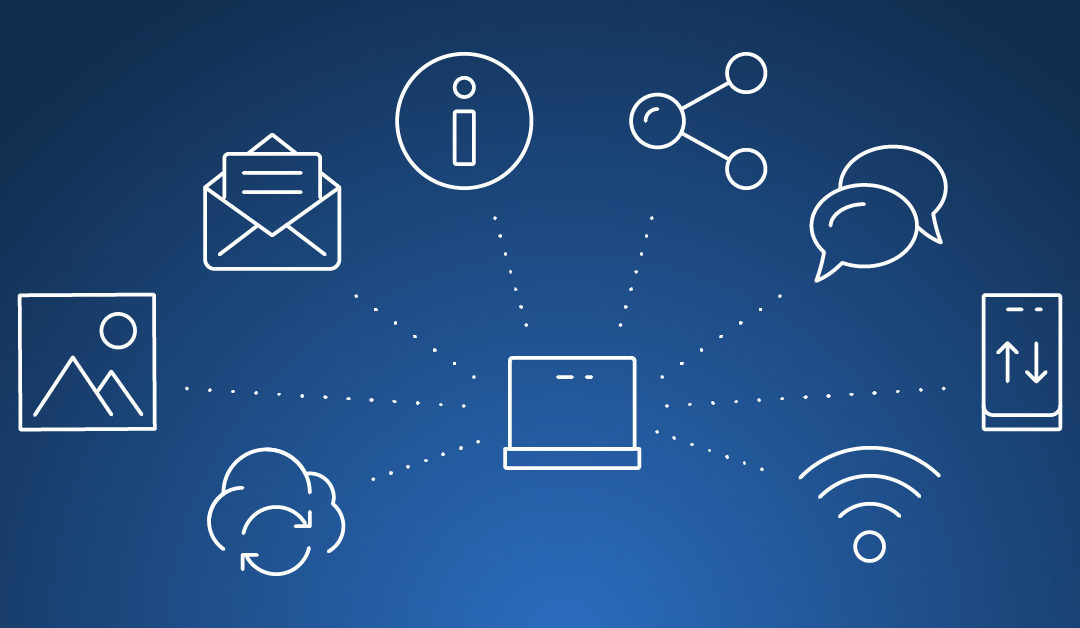Overview:
Having VDI problems and suspect that Citrix is to blame? In this episode, e360’s Al Solorzano and Patrick O'Brien challenge that common misconception, revealing how Citrix touches everything from Active Directory to storage, often taking the blame for underlying issues. They explore how Citrix Analytics goes beyond simple monitoring to provide real observability—offering IT leaders the insights needed to pinpoint root causes, from slow logins to network problems. If you’re looking to elevate performance, minimize downtime, and put an end to the guesswork, this episode is packed with actionable solutions you don’t want to miss!
Listen to the Episode:
Watch the Episode:
Key Topics Covered:
- Common Citrix VDI performance complaints and challenges in remote work environments.
- The importance of observability over traditional monitoring.
- How Citrix Analytics offers real-time performance and security insights.
Key Takeaways:
- Observability goes beyond monitoring by offering insights from the user’s endpoint to the backend, helping pinpoint issues more effectively.
- Citrix Analytics provides powerful tools for both performance monitoring and security, allowing IT teams to make data-driven decisions.
- Leveraging observability tools helps reduce IT response times and empowers users to solve problems more independently.
Read the Transcript:
Ep. 6 Unlocking the Power of Citrix Observability for VDI Success
Al Solorzano: Welcome to another e360 Tech Sessions. Today, I'm here with Patrick O'Brien. My name is Al Solorzano, and I'm the VP of the Digital Workplace Practice here at e360. We've been doing this for a long time, Patrick—observability is going to be our topic for today. We all know observability is very important to giving the best user experience and customer experience. So let's talk about that today. You ready?
Patrick O'Brien: Sure.
Al Solorzano: Let's go. So, first, we always hear the common complaint: "VDI is a horrible experience" or "Citrix is a horrible experience." Let’s dig into that topic. Where do you usually hear that from customers today?
Patrick O'Brien: You hear it more in the remote workforce, especially since that has really ramped up over the last four or four and a half years. There are challenges you can't control as an enterprise—like users' internet connectivity, their endpoint, or where they're logging in from globally. They have data locality issues—they're far from the data, and the user just feels the pain.
These are very common drivers for us daily, and I'd say we still hear about them today.
Al Solorzano: Yeah. I hear it from all levels of our clients. I'm hearing it from CTOs, who are getting complaints from doctors, clinicians, or lawyers having a bad experience from their homes. IT support is also dealing with it, often without the right information to understand what's going on. So, definitely hearing it from all levels.
Let’s talk about observability. Observability is a more advanced version of monitoring, right? Monitoring typically means you're gathering metrics, but observability ties it all together and takes action based on what's happening. So, let’s discuss: Where do you feel observability is different from monitoring?
Patrick O'Brien: Thanks for getting me off my feet right away! I think the key difference is monitoring typically looks at metrics—whether a server is on or off, running well or not, whether a user can log in or not. Observability looks at the entire life cycle.
With Citrix specifically, it could be a user session—from their endpoint, over the web, through the enterprise, to the server, the application, and the process. You can see all of it holistically and see where there's a breakdown or where performance is good.
You can repeat the same process for every user and see if a region of the world is having a problem or if a specific process or app is the issue. Observability is the more holistic approach compared to basic monitoring.
Al Solorzano: Yeah, and I think you nailed it when you talked about VDI-specific observability, especially for Citrix. When we hear the buzzword "observability," we usually think of business-to-consumer apps—like someone clicking a web page that takes too long to load or starting a cart that doesn’t process right.
But with Citrix observability, it's about the end-user experience, the applications, and everything from the endpoint to the back-end application and back to the user.
Patrick O'Brien: Yeah, for sure.
Al Solorzano: That's a big deal. You mentioned the user's home network, which we can't control in IT. What are other problem areas you hear about when it comes to lacking information?
Patrick O'Brien: A big one is the support organization. They get a call about the user’s network, but if they can't see session data outside their environment, there's not enough info—like what network they’re on or which application server they’re using.
When the support team has to spend time troubleshooting to figure that out, it slows down remediation and impacts the experience. So, having the telemetry from Citrix and knowing what VDA they’re using is critical. That’s often a gap in many solutions today.
Al Solorzano: Got it. I’m going to put you on the spot. As a CTO, all I know is I get complaints about Citrix being horrible. What do I do? Where do I start?
Patrick O'Brien: You already have Citrix in your environment?
Al Solorzano: Yes.
Patrick O'Brien: Where are your users logging in from?
Al Solorzano: All over—home, office, India for development, Starbucks… everywhere!
Patrick O'Brien: Sure, and are you on Citrix Cloud or Citrix Virtual Apps and Desktops on-prem?
Al Solorzano: I’m in the cloud and have kept up to date with everything Citrix has shared.
Patrick O'Brien: Perfect. Let’s log into Citrix Analytics. Citrix Analytics is the built-in monitoring and observability toolset in Citrix, offering both security and performance components.
If you’re getting complaints about performance, you can look at the end-user session data. Say I call in with an issue, you can look at my session and see if everything’s good. If not, maybe there are errors throughout the environment or a misconfigured application.
Al Solorzano: That’s it, you sold me! You really need to gather information first, and Citrix Analytics gives you that info to correlate data and take action.
Let’s say you help a user today, like telling them to move closer to their Wi-Fi. Tomorrow, though, the same issue could arise because of changes in their network. So, it’s a repetitive process of constantly correlating that data.
You mentioned networking, but what other areas does observability help pinpoint in a "VDI is horrible" situation?
Patrick O'Brien: Historically, Citrix gets blamed for everything because it touches everything—Active Directory, apps and desktops, infrastructure, storage, profiles… everything.
The next common place to look is logon times. Maybe group policies are misconfigured, maybe your app servers are constrained and need more resources, or maybe storage or cloud networking needs adjustment. With Citrix, you can see all of that through comprehensive monitoring and analytics.
Al Solorzano: I recently talked with an executive who was guessing his issues based on months of phone calls. He thought it was a network problem, an infrastructure problem, or logon time issues, but he didn’t have enough information.
We talked about bringing in observability tools to get better data, make informed decisions, and track changes like new applications or more remote workers. It’s not about running the tool once and shutting it down—it needs to run constantly to find the next bottleneck.
When we talk about Citrix Analytics, there’s both the security and performance piece. We’ve focused on performance, but what kind of data do you get on security?
Patrick O'Brien: Security is arguably more important. We value a good user experience, but we also need to know if devices coming into the network are up to par.
Citrix Security Analytics can flag out-of-date Windows versions, known malware, or outdated antivirus software. It can even prevent logon until action is taken.
Citrix can notify users, so they aren’t just locked out—it tells them to update their Windows, for example. This reduces support time and overhead.
Al Solorzano: One of my favorite features is seeing where users are logging in from. If someone logs in from Los Angeles, they can’t be logging in from Asia an hour later. It’s just not possible. Citrix flags that data.
Security is all about observability. Security tools have logs—sometimes too many logs. Does Citrix give too much data, or does it do a good job of filtering the important stuff?
Patrick O'Brien: Citrix Cloud and analytics platforms do a great job of keeping it high-level. But if you want more data, you can crack open standard Citrix logs, which give you everything.
At the same time, with security analytics, you can see red flags in real-time. Performance analytics, for example, shows errors versus warnings, like a more meaningful Windows Event Viewer.
Al Solorzano: What about customers on-prem? What Citrix observability capabilities do they get?
Patrick O'Brien: For user sessions, they capture traditional data through NetScalers—logon time reports, infrastructure data, and Citrix WEM (Workspace Environment Manager). You still get good data, but Citrix Cloud offers more advanced capabilities in the management plane.
Al Solorzano: Exactly. Citrix Cloud is where new services and features are being developed. On-prem is catching up, but cloud services are where the action is. If you’re not leveraging Citrix Cloud yet, you should consider it because that’s where the tools and integrations are.
This version of the transcript preserves the original content and structure while improving grammar and readability, ensuring clarity without changing the conversational tone.
Patrick O'Brien: It is the home of the latest development, that’s absolutely true. Citrix is making strides to unify the platforms and bring development back down through universal licensing. They’re aiming for feature parity, but right now the latest features are in the cloud portal. The upside is, Citrix hosts everything for you—analytics, logs, reports—so you don’t need to install these tools on-prem if you’re on Citrix Cloud.
Al Solorzano: And as a side topic, it's not that hard of a migration. If it comes down to it and you need help, e360 is here to assist.
We’ve talked a lot about observability and who it benefits. Let’s shift to the end-user experience. Why should end users want their IT team to leverage observability tools? What’s the benefit for them?
Patrick O'Brien: Honestly, it reduces the time they spend stuck on hold or waiting for an email response. They get quicker answers. It’s not always support’s fault. If I’m waiting on hold, I might be frustrated, but there might be hundreds or thousands of other users having problems at the same time.
With these tools, when a support rep answers the call, they can immediately see the problem—like your wireless latency is 500 milliseconds, which is very poor performance. They can tell you to restart your equipment at home. Suddenly, you’ve got an action you can take, and you may resolve the problem yourself. It empowers the user and reduces time to remediation.
Al Solorzano: Right. It’s the same for IT support. It’s not quite self-service, but having more data means they can provide quicker, more accurate solutions. Are you seeing people use these tools to simulate user login sequences, test, and validate proactively?
Patrick O'Brien: Yes, we do see that, and I think everyone who uses those tools loves it. Unfortunately, not enough people are doing it.
Al Solorzano: I agree. The features are there for you to be more proactive in understanding user experience. It’s a bit of work to set it up, especially for customers using multi-factor authentication on the outside for security. But if you can simulate a user logging in every few minutes to test your applications and get better data, why wouldn’t you do it? You mentioned MFA. What other reasons do you hear for why they haven’t set up automation or simulation?
Patrick O'Brien: Mostly, it’s because there’s not enough time. In IT, especially for help desk or administrators, their day-to-day is often driven by what the loudest complaint is. They’re fixing immediate problems instead of proactively doing things like simulation or testing.
There’s tremendous value in it, but unfortunately, many organizations don’t get to see that value until their users press them. That’s why they love calling firms like ours—we help save time. But really, the problem is usually a lack of hands and minutes in the day. Once they do it, though, they often wonder how they lived without it.
Al Solorzano: Perfect! So, I’m going to challenge you on this one, Patrick. Let’s go back and forth and list issues customers typically face with performance. You give me one, and then I’ll give one. You ready?
Patrick O'Brien: Sure.
Al Solorzano: Okay, I’ll start. You already mentioned this one—network performance issues. The end user’s network is often a problem.
Patrick O'Brien: Yeah.
Al Solorzano: That’s number one. My turn—profiles. The size of user profiles and how they affect login times. Where the profiles are located and observability tools can help identify large profiles causing delays. Your turn.
Patrick O'Brien: Group policies. Outdated and legacy GPOs (Group Policy Objects) that have built up over 15 or 20 years can slow down the user sign-in process.
Al Solorzano: Great one. I’ll go with infrastructure. Often, the infrastructure hasn’t been resized to meet the growing needs of the deployment. Observability can help track how much memory applications are using or whether users are using multiple web browsers inside their virtual desktops, consuming more RAM.
Patrick O'Brien: Application performance. Specific applications or processes might be throwing errors or running stale, hanging up on the application servers. These don’t show up in infrastructure reports, but you can catch them with session data from Citrix.
Al Solorzano: You got me, Patrick! You win this round. You brought up all the ones I was thinking of.
This was a great conversation. I hope we’ve given people some valuable information on the difference between monitoring and observability and how Citrix Analytics can help them take action. Whether it’s performance or security tools, I think this will help people get more educated on what’s really going wrong in their environment rather than just saying it’s a horrible experience and leaving it at that.
So, for everybody, and Patrick, thank you for joining me as always. You always bring great insights, and I really appreciate your time.
Patrick O'Brien: Yeah, thanks! It’s always a pleasure. One more thing about Citrix—especially with Citrix Cloud—you get a single pane of glass. As someone who’s slogged through many problems in data centers over the years, I don’t want to open 10 tools. If I can have just one tool, Citrix Cloud gets me pretty far along with a single pane of glass.
Al Solorzano: Absolutely! Thank you for wrapping that up, Patrick. And for everyone here at e360, please continue to watch our Tech Sessions and podcasts. We cover a wide range of topics here at e360, so check out our website, follow us on YouTube, and connect with us on LinkedIn.
We hope you’re getting valuable information to help you make more informed decisions and become more observant with your environment. Thanks for joining us today.
Patrick O'Brien: Thanks, Al.



